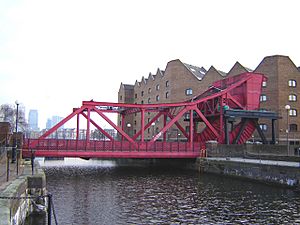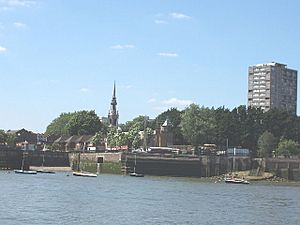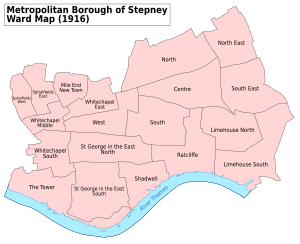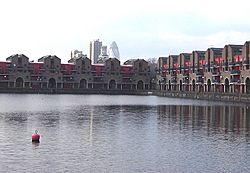Shadwell facts for kids
Quick facts for kids Shadwell |
|
|---|---|
 Shadwell Basin Bridge |
|
| Population | 15,110 (2011 Census. Ward) |
| OS grid reference | TQ355805 |
| London borough | |
| Ceremonial county | Greater London |
| Region | |
| Country | England |
| Sovereign state | United Kingdom |
| Post town | LONDON |
| Postcode district | E1, E1W |
| Dialling code | 020 |
| Police | Metropolitan |
| Fire | London |
| Ambulance | London |
| EU Parliament | London |
| UK Parliament |
|
| London Assembly | |
Shadwell is a lively area in East London, England. It's part of the London Borough of Tower Hamlets, located about 3 miles (4.8 km) east of Charing Cross. Shadwell sits right on the north bank of the River Thames, between Wapping (to the west) and Ratcliff (to the east). Because it's by the river, its history and character have always been closely linked to sea trade and shipping.
Long ago, Shadwell was a small village, or hamlet, within a larger area called Stepney. In 1670, it became its own official parish. This area included places south of Cable Street, like Shadwell Basin and the King Edward Memorial Park.
Contents
Shadwell's Story: A Look Back in Time
What's in a Name? The Origin of "Shadwell"
Hundreds of years ago, in the 13th century, this area was a low, wet marsh called Scadflet. This name came from an old Anglo-Saxon word, fleot, which means a shallow creek or bay.
Later, a church dedicated to St Chad had a spring nearby that filled a well. People started to think the name came from "Chadwelle" because of St. Chad's well. This name then changed over time to Shadwell.
Roman Times in Shadwell
In 1975, archaeologists found exciting clues about a port in Shadwell. This port was used during the time of Roman rule in Britain, especially busy in the 3rd century AD. It seems large ships used to sail from here into the City of London.
Later, the water levels dropped, and the port was mainly used for a public bathhouse. This bathhouse was near St George in the East and was used for about 300 years. Archaeologists also found signs of a Roman signal tower in Shadwell. Around 1615, a Roman cemetery with two coffins was also discovered here.
How Shadwell Was Governed Over Time
Shadwell was once part of the historic county of Middlesex. However, local matters were mostly handled by the Tower Division, also known as the Tower Hamlets.
The Tower Division's role ended in 1889 when Shadwell became part of the new County of London. Then, in 1965, the County of London was replaced by Greater London, which is how it is today.
Shadwell in the 16th and 17th Centuries
During the Middle Ages, the eastern part of Shadwell's waterfront was drained. The western part was drained later, during the time of King Henry VIII. This was done because London's sea trade was growing a lot in the 16th century.
Many new buildings, not always of the best quality, quickly appeared along the river in East London, reaching Shadwell in the late 1500s. An old writer, John Stow, mentioned that elm trees were cut down to make room for these new homes.
Away from the river, much of the area was still open land. In 1650, Shadwell had 703 buildings. Most were one or two stories high, and many were divided into smaller homes. About 3,500 people lived in Shadwell then.
In the 1660s, a tax called the hearth tax was started. But about half of Shadwell's residents were too poor to pay it.
In 1669, a man named Thomas Neale bought land in Shadwell. He helped Shadwell become its own official parish. Neale also built 289 homes, a mill, and a market. He even set up a waterworks using large ponds left from the drained marshland. This provided fresh water for Shadwell and Wapping.
Shadwell's sea-related businesses grew, with places for making ropes, tanning leather, brewing beer, and building ships. There were also many taverns. In 1674, Shadwell's population had grown to about 8,000 people. The area's success was helped by good road connections to London.
Shadwell in the 18th and 19th Centuries
By the mid-1700s, a place called Shadwell Spa opened, known for its special water. People used this water for medicine, and salts from it were used by local fabric printers to set their dyes. Many houses in Shadwell were rebuilt around this time.
Homes were often small, two-story houses with one room on each floor. They were lived in by sailors, boatmen, coal workers, shopkeepers, and craftspeople.
In 1794, a huge fire destroyed many houses on the Ratcliffe Highway in Shadwell. It was one of the biggest fires since the Great Fire of London. It also ruined many boats and a lot of sugar.
The Shadwell Waterworks, which was the first in London to use a Watt steam engine in 1788, was sold in 1801.
Today, the area is dominated by the Shadwell Basin, a former enclosed dock. Its construction destroyed much of the older settlement, which had become crowded areas. The basin was once the eastern entrance to the London Docks. It's actually two basins, built between 1828-32 and 1854–58. A new entrance in 1832 connected Shadwell to the River Thames. Shadwell Basin is the only one of three original dock entrances still existing today.
In 1865, a ship called HMS Amazon docked at Shadwell Basin. It picked up about 800 Mormons who were moving to America. In 1869, the Blue Jacket, then the fastest clipper ship in the world, started its journey to Canterbury, New Zealand from Shadwell Basin.
By 1844, Shadwell had a population of 10,060. Watney Market became a busy shopping area around this time.
In the 19th century, Shadwell was home to many lascar seamen from British India, brought by the East India Company. There were also people of mixed heritage, and smaller communities of Chinese and Greek seamen.
During Victorian times, Shadwell and the East End were often seen as difficult places to live. An 1889 book described the area as a "revolting spectacle." Even Charles Dickens mentioned a journey to Shadwell in his unfinished novel, describing it as a "miserable court."
In 1885, Shadwell Fish Market opened as an alternative to Billingsgate Fish Market. Even though it had good river access, it wasn't successful and closed in 1914. The site later became King Edward Memorial Park in 1922, opened by King George V. This was Shadwell's first park.
Shadwell in the 20th Century
In 1906, the Corporation of London helped pay to make Shadwell High Street wider. In 1916, a terrible fire at a sack factory killed seven women. In 1934, a 10-pound (4.5 kg) bomb was found under Shadwell High Street, believed to be from German air raids during World War I.
In 1936, Shadwell residents were very involved in the Battle of Cable Street. This event happened nearby when Oswald Mosley's fascists tried to march through the East End to scare the large Jewish population. Thousands of protestors blocked their way, and the police had to stop the march. Workers in Shadwell continued to oppose the fascists.
In 1969, the Shadwell Docks, like other London docks, closed down. The Tower Hamlets Council bought them. In the 1970s, the docks became run-down. Later, the London Docklands Development Corporation bought them and built 169 new homes by the basin in 1987.
The Watney Market area was also rebuilt during the 1970s and 1980s. In 1987, Shadwell DLR station opened, connecting Shadwell to other parts of London.
Shadwell's Parish Church

St. Paul's Shadwell with St. James Ratcliffe is often called the Church of Sea Captains. It was first built in 1656 as a smaller chapel. In 1669, it was rebuilt as the main Parish Church of Shadwell. It was one of the last churches rebuilt after the Restoration period. It was rebuilt again in 1820.
Famous people like Captain James Cook were active members of this church. The preacher John Wesley also gave sermons there sometimes.
Local Areas and Population
Electoral Wards
The northern part of Shadwell is in the Shadwell electoral ward. Since 2018, this ward no longer includes the riverside part of Shadwell.
The southern part of Shadwell is in the St Katharine's and Wapping electoral ward.
Who Lives in Shadwell?
According to the 2011 census, 15,110 people lived in Shadwell.
About 52% of the people in Shadwell are of Bangladeshi origin. White British people make up 20% of the population. The next largest group is Other White people at 9%. About 52.9% of residents were born in the United Kingdom, and 20.8% were born in Bangladesh.
The most common religion in Shadwell is Islam, with 54.8% of people identifying as Muslim. The next highest is Christianity, with 20.6% identifying as Christian.
Famous People from Shadwell
Many interesting people have lived in or come from Shadwell:
- Jane Randolph Jefferson (born 1720) – She was the mother of Thomas Jefferson, a famous American president.
- Eliza Roberts (1802-1878) – She was a Head Nurse who worked with Florence Nightingale during the Crimean War. She was born in Shadwell.
- Sir William Henry Perkin (1838-1907) – Born in Shadwell, at just 18, he discovered the first aniline dye while experimenting at his home.
- Walter Pater (1839-1894) – A well-known essayist and critic.
- Frederick Albert Bridge (1841-1917) – A photographer, singer, conductor, and choirmaster.
- Mildred Gordon (1923-2016) – She was a Member of Parliament for the area and a teacher at Shadwell's Nicholas Gibson School. She lived in Shadwell until 1962.
- Norman Giller (born 1940) – A sports historian and author, born and lived here until 1960.
- Bob Crow (1961-2014) – A well-known trade union leader.
- Jah Wobble – A musician and writer who lived in Shadwell from the early 1980s to the mid-1990s.
Learning in Shadwell: Schools
For more details on schools in Shadwell, you can look at the List of schools in Tower Hamlets.
Some local schools include Blue Gate Fields Primary School, Bigland Green Primary School, and Bishop Challoner Catholic Collegiate School. There is also Mulberry School For Girls.
Getting Around Shadwell: Transport
Train and DLR Stations
Shadwell railway station is just north of Cable Street, which used to be the northern border of Shadwell. It's on the London Overground's East London line and is in Travelcard Zone 2. You can catch direct trains to places like Dalston Junction, Highbury & Islington, and Clapham Junction.
Shadwell DLR station is very close, about 50 meters north of the railway station. It uses the old Shadwell & St. George's East building. The DLR runs regularly between Bank and Lewisham.
Bus Services
London bus services in Shadwell are run by companies like Blue Triangle, London Central, and Stagecoach London. Bus routes include the 15, 100, 108, 115, 135, D3, and the night bus N15. These buses connect Shadwell to other parts of East and Central London.
THCH Hop Festival: A Local Tradition
In 2006, a local housing group called Tower Hamlets Community Housing (THCH) built new flats in Shadwell, called Thirza House. As part of this new development, THCH created a hop garden.
Since 2007, THCH has held a Hop Festival every September in this garden. It celebrates the old tradition of East Enders traveling to Kent's hop gardens to harvest hops. THCH has even made booklets with historical photos of people harvesting hops. In 2009, the hops from Shadwell were used by Brodies Brewery to make a new beer called "Old Hopper's Brew."
See also
- Stepney Historical Trust
- Wilton's Music Hall
|





